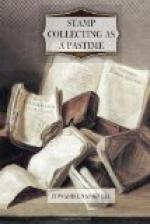This stamp may safely be placed at the head of great rarities. Of its value it is impossible to form any opinion. If a dealer had the disposal of the copy in question, he would probably want between L1,000 and L2,000 for it, with a decided preference for the larger sum.
[Illustration:]
Mauritius, “Post Office,” 1d. and 2d.—The best known, the most quoted, and probably the most popular of all the great rarities is the “Post Office” Mauritius, so called because the words “Post Office” were inscribed on one side of the stamp instead of the words “Post Paid.” There were two values, 1d. and 2d. They were designed and engraved by a local watchmaker, and were printed from single dies, and issued in 1847. The tedious process of printing numbers of stamps from single dies was soon abandoned, and only 500 copies of each value were struck. Of those 1,000 stamps only twenty-two copies are known to exist to-day. There are in the hands of leading collectors two copies of the 1d. unused, and three copies of the 2d. unused, twelve copies of the 1d. used, and five copies of the 2d. used. These rarities were only in use for a few days, and were mostly used in sending out invitations to a ball at Government House.
The value, according to condition, is from L800 upwards for each value, but unused they are of course worth a great deal more.
[Illustration:]
Hawaii, 1851, 2 cents, blue.—Like so many rare stamps, this first issue of Hawaii was designed and set up from type in a printer’s office. About twelve copies are known to exist. The stamp was in use but a very short time, as the Post Office of Honolulu was burnt down, and the stock of stamps of this first issue was completely destroyed.
This 2 cents stamp is worth about L750.
[Illustration:]
British Guiana, 1850, 2 cents.—This is popularly known as the 2 cents circular Guiana, because of its shape. A notice in the local Official Gazette, dated February, 1851, announced that “by order of His Excellency the Governor, and upon the request of several of the merchants of Georgetown, it is proposed to establish a delivery of letters twice each day through the principal streets of this city.” Certain gentlemen were named as having consented to receive letters for delivery at their respective stores, and it was further announced that “each letter must bear a stamp, for which 2 c. will be charged, or it will not be delivered, and when called for will be subject to the usual postage of 8 c.” A supply of the required 2 c. stamps was provided by a locally type-set design enclosed in a ring. It is said that this delivery of letters was discontinued soon after it was started, hence rarity of the stamp.
Only eleven copies of this quaint postage stamp are known, and its market value is probably somewhere about L600.
[Illustration:]
Moldavia, 1858, 81 paras.—This rare stamp formed one of a set of four of the first postage stamps issued in Roumania. The values were 27 paras for single letters travelling, and not carried more than about seventy miles, 54 paras for double that distance, 81 paras for heavier letters, and 108 paras for registered letters, all within the limits of Moldavia. The 81 paras is the rarest of the series, as will be seen from the following inventory taken in February, 1859, of the then unsold stock:—




